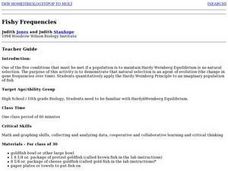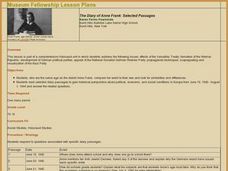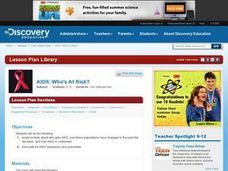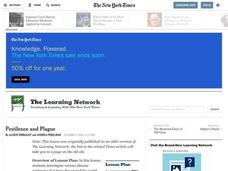Curated OER
Hardy-Weinberg Equilibrium According to Hoyle: OR, Population Genetics or Platypapyrus foursuitii
Students use this exercise to help achieve a working knowledge of the Hardy-Weinberg Equilibrium without recourse to algebra. After participating in this activity, students gain a feeling for the significance of the Hardy-Weinberg...
Curated OER
Space Age Technology Comes to Earth
Students explore jobs related to agriculture. In this technology/agriculture instructional activity, students recognize the importance of natural resources and agriculture on the use of Range Rambler software. Students complete an...
Curated OER
The Incorporation of America
The incorporation and industrialization of America is covered in this image-rich slide show. While text is limited, there is no shortage of great images showing the progression and causes of American Industrialization. Perfect...
Curated OER
European Colonialism in Africa
The uglier side of European colonization of Africa is detailed in these slides, which include pictures and information about the Belgian Congo, the Dutch South Africa, and Britain's ongoing tensions with the Boers. Students will be...
Institute of Electrical and Electronics Engineers
Water Tower Challenge
Providing clean water to a town is quite a feat... is your class up for the challenge? After a short reading about water towers, groups work together to design a working water delivery system. The water flow must be adjustable (able to...
Curated OER
Aboriginal Peoples
Students examine data from the 2001 Census on the Aboriginal population. They cover the topics of distribution of the Aboriginal population across the country, the three Aboriginal groups, age, and language. Students build interpretive...
Curated OER
Family Recent Demographic Changes
For this Recent Demographic Changes worksheet, students answer 14 questions in short written responses. Suggested point values are provided.
Curated OER
Examine Your State Government's Demographics
How is your state government organized? How many elected officials are women? What is the mean age of your state representatives? Young scholars answer these questions in a research project before creating a chart to reflect their...
Curated OER
Peter Rabbit Meets Charles Darwin
Students start to think of evolution in terms of populations. The class follows a cartoon scenario of a rabbit population in which there is selection and change of gene frequency. They receive copies of the scenario or the whole thing...
Curated OER
Aboriginal Statistics
Fourth graders analyze statistics of Native Americans by creating graphs. In this data analysis lesson, 4th graders define different statistical terms and practice finding those statistics from groups of numerical information about...
Curated OER
Then and Now
Students explore population and come to understand how it changes over time. In this census instructional activity, students discover what population is and how it changes as they participate in age-appropriate activities.
Curated OER
M & M Lab
Students investigate how selection occurs in a random population. The concept is that selection affects evolution.They demonstrate how selection occurs and will analyze shifts in the populations. They design their conclusions with M...
Curated OER
Border to Border
Students use the Internet to gather information on the country of Mexico. They also discover the culture of their people and compare them with the United States population. They take a virtual tour of some of Mexico's most historical ruins.
Curated OER
Tracking the Monster
Learners exchange fake bodily fluids with other students. They track the spread of the "infection" throughout the population of learners and determine where the infection began in the class. Every student in the class choose a test...
Curated OER
Fishy Frequencies
Tenth graders demonstrate that natural selection is an agent of evolution. They quantitatively apply the Hardy-Weinberg Principle to an imaginary population of fish. They utilize math and graphing skills, collecting and analyzing data,...
Curated OER
Ship Ahoy!
Fourth graders develop a schedule of fitness activities to meet the needs of a diverse group of people with a wide range of ages, physical abilities, and fitness levels. An instructional manager be assigned to each station to lead the...
Curated OER
The Diary of Anne Frank: Selected Passages
Students read the novel, "The Diary of Anne Frank". Using the internet, they gather information on the effect of the Versailles Treaty, formation of the Weimer Republic and the Nazi Party on the Holocaust. They view propaganda...
Curated OER
Viruses and Host Evolution
Students are organized into groups of four. On Day 1 they are given a worksheet about viruses and their effects on the evolution of a rabbit population. After about 30 minutes of group work, a class discussion of the material begins. ...
Curated OER
Who's at Risk?
Students are asked what do they comprehend about HIV, such as: how does it get transmitted, and what happens to the body once someone contracts the virus. They discuss ways that people can avoid getting and spreading AIDS. Students...
Curated OER
Exploring Archaeology and Trade in the Middle School Latin Class
Learners in a Latin class focus on archeology and trade from the Hellenistic period through the Middle Ages. In groups, they read various stages of a primary source documents in which they discuss and answer questions. To end the...
Curated OER
Comparing Countries
Students use a graphic organizer to research, compare and contrast two countries. They write a brief (or detailed - depending on age) report of their findings.
Curated OER
How Does a Green Plant Grow?
Students of all ages can explore the question "how do seeds grow?", design an experiment to answer the question, predict the outcome of the experiment then conduct the experiment.
Curated OER
Pestilence and Plague
Young scholars investigate various disease epidemics that have devastated the world population at different points in history and examine the diseases' effects on the countries they impacted.
Curated OER
Charts, Maps, and Graphs Lesson on the Holocaust
Young scholars practice interpreting data. In this Holocaust lesson, students research selected Internet sources and examine charts, maps, and graphs regarding the Jewish populations in and out of Europe. Young scholars respond to...























